A New Sparse Adaptive Channel Estimation Method Based on Compressive Sensing for FBMC/OQAM Transmission Network
Abstract
:1. Introduction
2. System Model
3. Compressive Sensing Based Preamble Channel Estimation
3.1. Preamble Structures
3.2. CS Theory for Channel Estimation
3.3. Adaptive Regularized Compressive Sampling Matching Pursuit Algorithm
3.3.1. CS Algorithms Overview
3.3.2. Proposed Algorithm
- Input: measurement matrix , the measurement vector , the initial step size
- Output: a -sparse approximation of the channel
- (1)
- Initialization: residual , iterative , initial step , , index value set .
- (2)
- Set a threshold value , if the reconstruction satisfies , and stop the iteration; otherwise, continue to Step 3. The deviation norm 2 is chosen as the basis of the iterative termination. In the simulation, .
- (3)
- Calculate the correlation coefficient by the Equation (13), which calculates the absolute value of inner product between residual and each atom of measurement matrix , and deposit the index values corresponding the maximum values from to :
- (4)
- Regularization: using Equation (14) to regularizechoose with the maximal energy , add the set to the index set , and update the support set .
- (5)
- Use Equation (15) to get , according to the backtracking mechanism, take atoms corresponded to the largest elements of to , update the support set :
- (6)
- Update the residual
- (7)
- Make a comparison between the update residual and the last iteration residual; if , , return to Step 3; otherwise, and return to Step 2.
4. Simulation Results
5. Conclusions
Acknowledgments
Author Contributions
Conflicts of Interest
References
- FP7-ICT PHYDYAS Project. Prototype Filter and Structure Optimization, Project Deliverable D5.1, (Section 5.2.3). Available online: http://www.ict-phydyas.org/delivrables (accessed on 20 June 2016).
- Shao, K.; Alhava, J.; Kaakinen, J.Y.; Renfors, M. Fast-convolution implementation of filter bank multicarrier waveform processing. In Proceedings of the 2015 IEEE International Symposium on Circuits and Systems, Lisbon, Portugal, 24–27 May 2015; pp. 978–981.
- Nadal, J.; Nour, C.A.; Baghdadi, A. Low-complexity pipelined architecture for FBMC/OQAM transmitter. IEEE Trans. Circuits Syst. II Express Briefs 2016, 63, 19–23. [Google Scholar] [CrossRef]
- Schellmann, M.; Zhao, Z.; Lin, H.; Siohan, P.; Rajatheva, N. FBMC-based air interface for 5G Mobile: Challenges and proposed solutions. In Proceedings of the 9th International Conference on Cognitive Radio Oriented Wireless Networks and Communications, Oulu, Finland, 2–4 June 2014; pp. 102–107.
- Nadal, J.; Nour, C.A.; Baghdadi, A.; Lin, H. Hardware prototyping of FBMC/OQAM baseband for 5G mobile communication. In Proceedings of the 2014 25th IEEE International Symposium on Rapid System Prototyping, New Delhi, India, 16–17 October 2014; pp. 72–77.
- David, L.-P.; Chu, X.L.; Athanasios, V.V.; Holger, C. On Distributed and Coordinated Resource Allocation for Interference Mitigation in Self-Organizing LTE Networks. IEEE/ACM Trans. Netw. 2012, 21, 1145–1158. [Google Scholar]
- Zhang, Z.S.; Chai, X.M.; Long, K.P.; Vasilakos, A.V. Full deplex techniques for 5G networks: Self-interference cancellation, protocol design, and relay selection. IEEE Commun. Mag. 2015, 53, 128–137. [Google Scholar] [CrossRef]
- Zhang, Z.S.; Wang, X.Y.; Long, K.P.; Vasilakos, A.V. Large-scale MIMO-based wireless backhaul in 5G networks. IEEE Wirel. Commun. 2015, 22, 58–66. [Google Scholar] [CrossRef]
- Rodger, J.A. Toward reducing failure risk in an integrated vehicle health maintenance system: A fuzzy multi-sensor data fusion Kalman filter approach for IVHMS. Expert Syst. Appl. 2012, 39, 9821–9836. [Google Scholar] [CrossRef]
- Chen, X.W.; Zhao, M.J.; Xu, C.L. Preamble-Based Channel Estimation Methods with High Spectral Efficiency for Pulse Shaping OFDM/OQAM Systems. In Proceedings of the 6th International Conference on Wireless Communications and Signal Processing, Hefei, China, 23–25 October 2014; pp. 1–6.
- Razavi, R.; Xiao, P.; Tafazolli, R. Information Theoretic Analysis of OFDM/OQAM with Utilized Intrinsic Interference. IEEE Signal Process. Lett. 2015, 22, 618–622. [Google Scholar] [CrossRef]
- Siohan, P.; Siclet, C.; Lacaille, N. Analysis and design of OFDM/OQAM systems based on filterbank theory. IEEE Trans. Signal Process. 2002, 50, 1170–1183. [Google Scholar] [CrossRef]
- Chang, R. High-speed multichannel data transmission with band limited orthogonal signals. Bell Syst. Tech. 1996, 45, 1775–1796. [Google Scholar] [CrossRef]
- Saltzberg, B. Performance of an efficient parallel data transmission system. IEEE Trans. Commun. Technol. 1967, 15, 805–811. [Google Scholar] [CrossRef]
- Lele, C.; Javaudin, J.P.; Legouable, R.; Skrzypczak, A.; Siohan, P. Channel estimation methods for preamble-based OFDM/OQAM modulations. Eur. Trans. Telecommun. 2008, 19, 741–750. [Google Scholar] [CrossRef]
- Du, J.F.; Signell, S. Novel Preamble-Based Channel Estimation for OFDM/OQAM Systems. In Proceedings of the IEEE International Conference on Communications, Dresden, Germany, 14–18 June 2009; pp. 1–6.
- Deng, F.; He, X.; Cheng, G.B.; Li, S.Q. An effective Preamble-based Channel Estimation Structure for OFDM/OQAM Systems. In Proceedings of the 6th International Conference on Wireless Communications Networking and Mobile Computing, Chengdu, China, 23–25 September 2010; pp. 1–4.
- Hu, S.; Wu, G.; Li, T.; Xiao, Y.; Li, Q.S. Preamble design with ICI cancellation for channel estimation in OFDM/OQAM system. IEICE Trans. Commun. 2010, E93-B, 211–214. [Google Scholar] [CrossRef]
- Cui, W.; Qu, D.; Jiang, T.; Boroujeny, B.F. Coded Auxiliary Pilots for Channel Estimation in FBMC-OQAM Systems. IEEE Trans. Veh. Technol. 2015, 64, 1–11. [Google Scholar] [CrossRef]
- Fusco, T.; Izzo, L.; Petrella, A.; Tanda, M. Blind Symbol Timing Estimation for OFDM/QOAM Systems. IEEE Trans. Signal Process. 2009, 57, 4952–4958. [Google Scholar] [CrossRef]
- Hou, W.K.; Champagne, B. Semiblind Channel Estimation for OFDM/OQAM Systems. IEEE Signal Process. Lett. 2015, 22, 400–403. [Google Scholar] [CrossRef]
- Berger, C.R.; Wang, Z.; Huang, J.; Zhou, S. Application of compressive sensing to sparse channel estimation. IEEE Commun. Mag. 2010, 48, 164–174. [Google Scholar] [CrossRef]
- Bajwa, W.U.; Haupt, J.; Sayeed, A.M.; Nowak, R. Compressed Channel Sensing: A New Approach to Estimating Sparse Multipath Channels. IEEE Proc. 2010, 98, 1058–1076. [Google Scholar] [CrossRef]
- Xiang, L.; Luo, J.; Vasilakos, A. Compressed data aggregation for energy efficient wireless sensor networks. In Proceedings of 2011 8th IEEE Communications Society Conference on Sensor, Mesh and ad hoc Communications and Networks, Salt Lake City, UT, USA, 27–30 June 2011; pp. 46–54.
- Jiang, D.; Xu, Z.; Chen, Z.; Han, Y.; Xu, H. Joint time-frequency sparse estimation of large-scale network traffic. Comput. Netw. 2011, 55, 3533–3547. [Google Scholar] [CrossRef]
- Gui, G.; Peng, W.; Adachi, F. Improved adaptive sparse channel estimation based on the least mean square algorithm. In Proceedings of the 2013 IEEE Wireless Communications and Networking Conference, Shanghai, China, 7–10 April 2013; pp. 3105–3109.
- Jiang, D.; Wang, Y.; Yao, C.; Han, Y. An effective dynamic spectrum access algorithm for multi-hop cognitive wireless networks. Comput. Netw. 2015, 84, 1–16. [Google Scholar] [CrossRef]
- Meng, J.; Yin, W.T.; Li, Y.Y.; Nguyen, N.T.; Han, Z. Compressive Sensing Based High-Resolution Channel Estimation for OFDM System. IEEE J. Sel. Top. Signal Process. 2012, 6, 15–25. [Google Scholar] [CrossRef]
- Hu, D.; Wang, X.D.; He, L.H. A New Sparse Channel Estimation and Tracking Method for Time-Varying OFDM Systems. IEEE Trans. Veh. Technol. 2013, 62, 4648–4653. [Google Scholar]
- Pan, H.; Xue, Y.; Mei, L.; Gao, F. An improved CoSaMP sparse channel estimation algorithm in OFDM system. In Proceedings of the 2015 IEEE International Conference on Signal Processing, Communications and Computing, Ningbo, China, 19–22 September 2015; pp. 1–4.
- Wang, H.; Du, W.C.; Bai, Y. Compressed Sensing Based Channel Estimation for OFDM Transmission under 3GPP Channels. Int. J. Future Gener. Commun. Netw. 2016, 9, 85–94. [Google Scholar] [CrossRef]
- Liu, X.M.; Cai, Z.W.; .Jia, A.L.; Wang, P.; Ou, J.L. A Novel Channel Estimation Method Based on Compressive Sensing for OFDM/OQAM Systems. J. Comput. Inf. Syst. 2013, 9, 5955–5963. [Google Scholar]
- Tropp, J.; Gilbert, A. Signal recovery from random measurements via orthogonal matching pursuit. IEEE Trans. Inf. Theory 2007, 53, 4655–4666. [Google Scholar] [CrossRef]
- Needell, D.; Tropp, J.A. CoSaMP: Iterative signal recovery from incomplete and inaccurate samples. Commun. ACM 2010, 53, 93–100. [Google Scholar] [CrossRef]
- Du, J.F.; Signell, S. Time Frequency Localization of Pulse Shaping Filters in OFDM/OQAM Systems. In Proceedings of the 6th International Conference of Information, Communications and Signal Processing, Singapore, 10–13 December 2007; pp. 1–5.
- Do, T.T.; Gan, L.; Nguyen, N.; Tran, D.T. Sparsity adaptive matching pursuit algorithm for practical compressed sensing. In Proceedings of the 2008 42nd Asilomar Conference on Signals, Systems and Computers, Pacific Grove, CA, USA, 26–29 October 2008; pp. 518–587.
- Candes, E.; Romberg, J.; Tao, T. Robust uncertainty principles: Exact signal recovery from highly incomplete frequency information. IEEE Trans. Inf. Theory 2006, 52, 489–509. [Google Scholar] [CrossRef]
- Donoho, D. Compressed Sensing. IEEE Trans. Inf. Theory 2006, 52, 1289–1306. [Google Scholar] [CrossRef]
- Baraniuk, R.G. Compressive Sensing. IEEE Signal Process. Mag. 2007, 24, 118–121. [Google Scholar] [CrossRef]
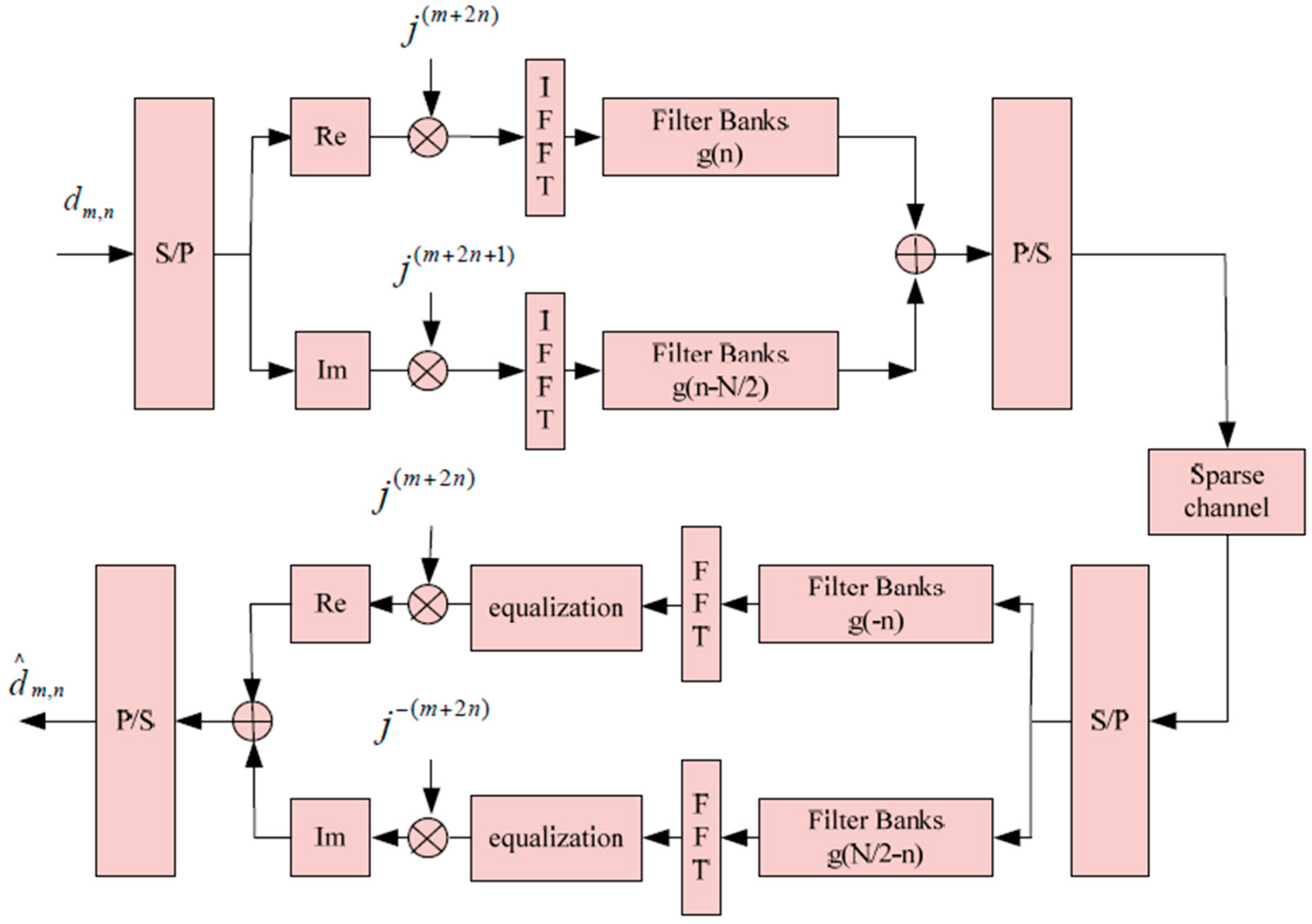

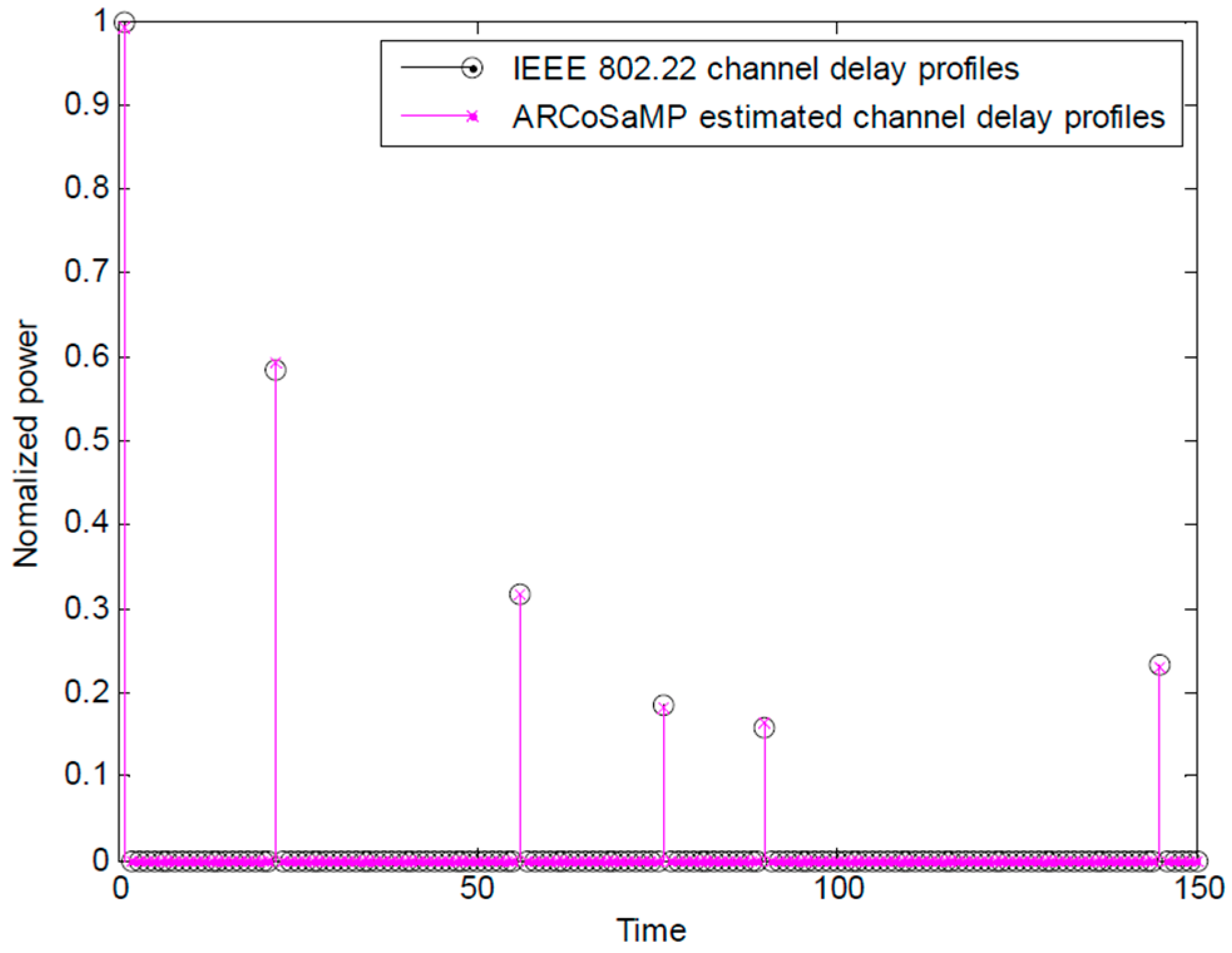
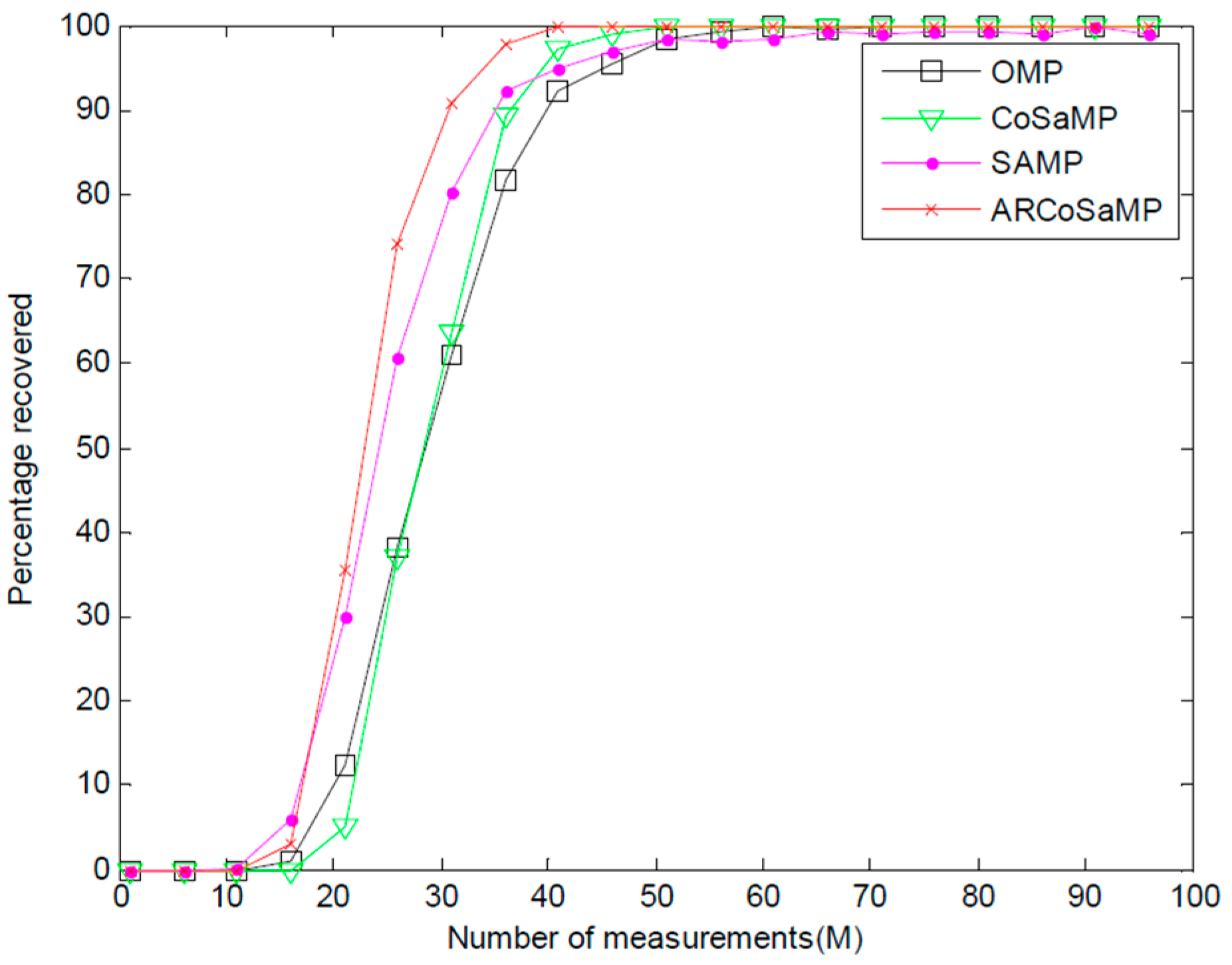
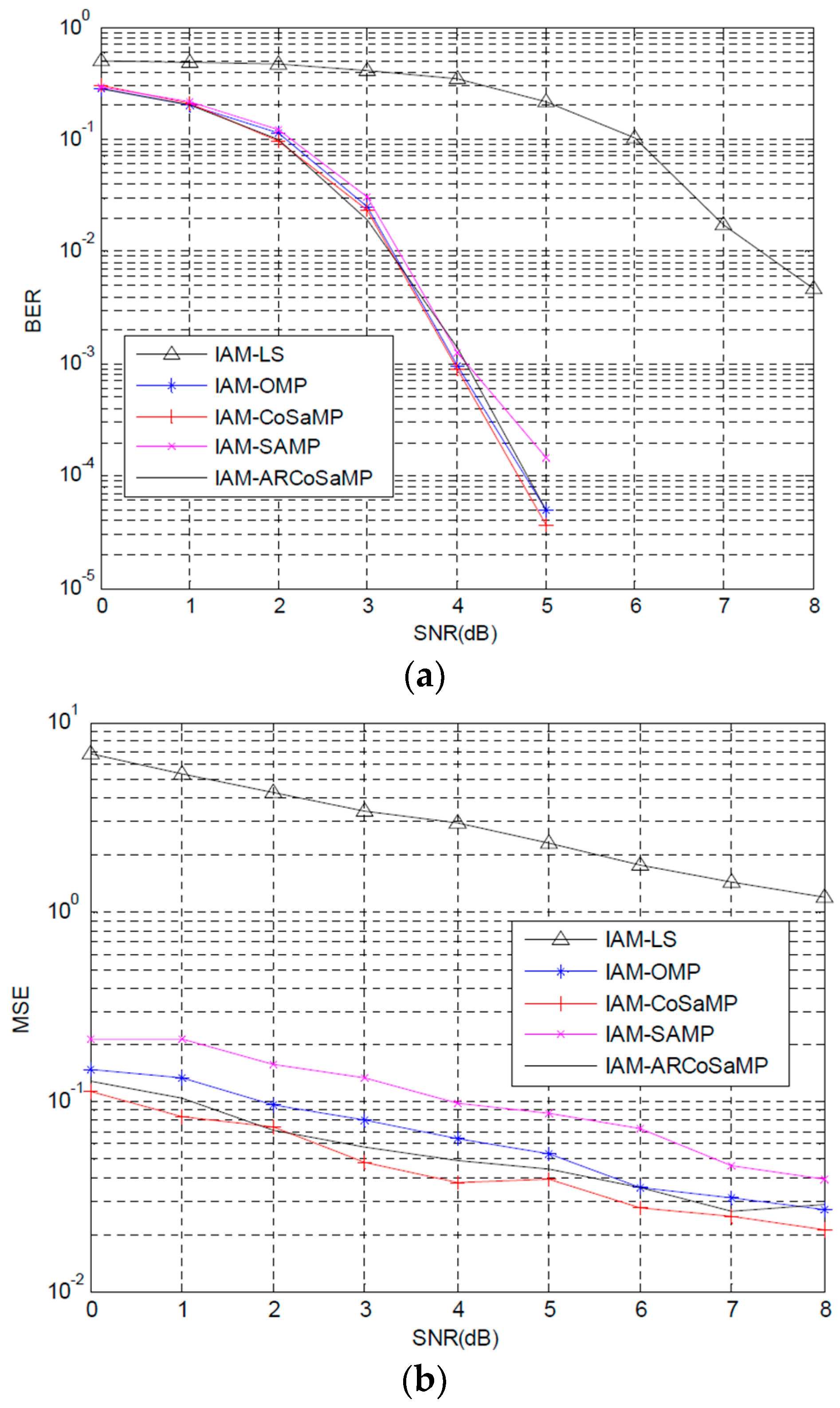
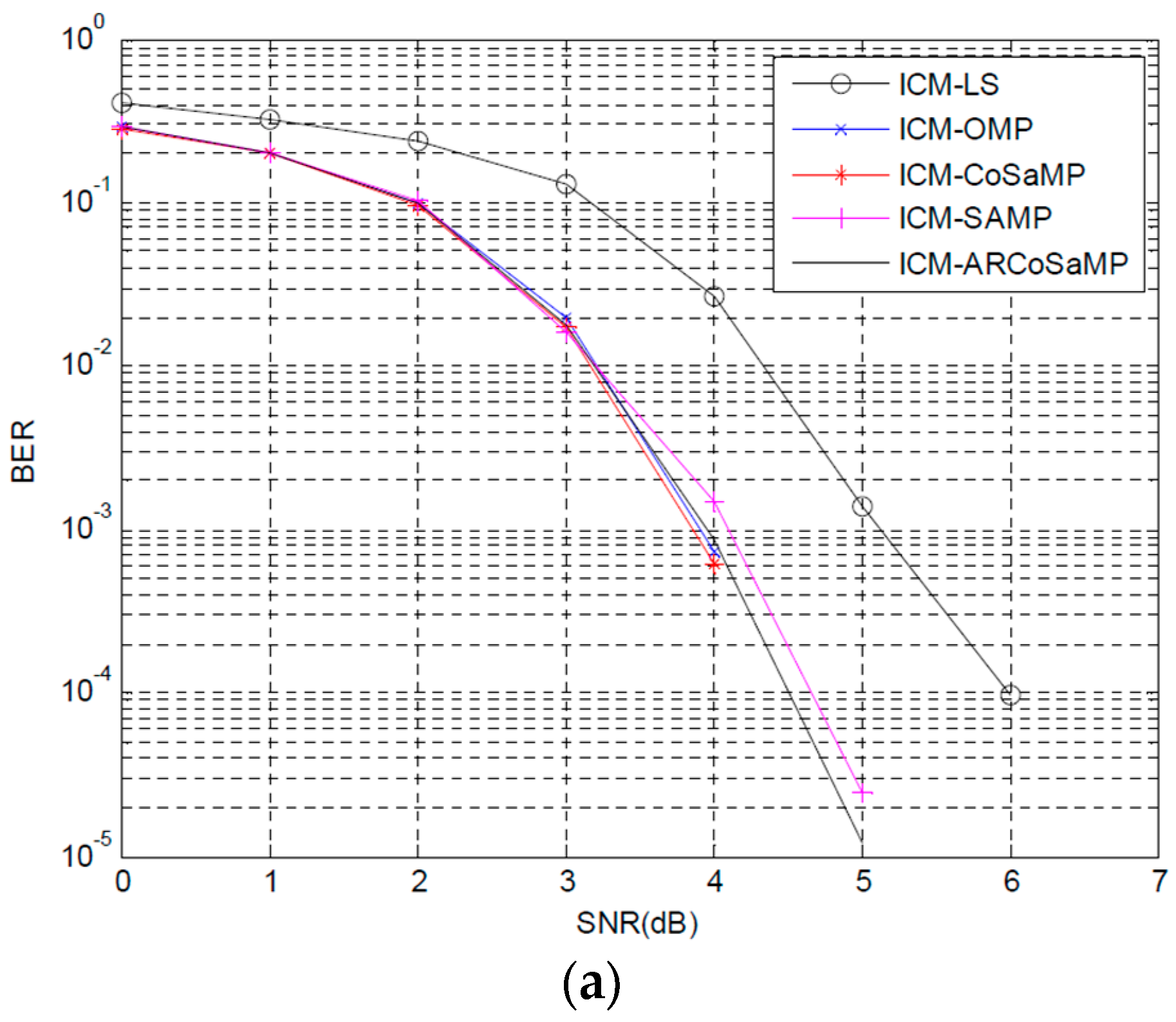
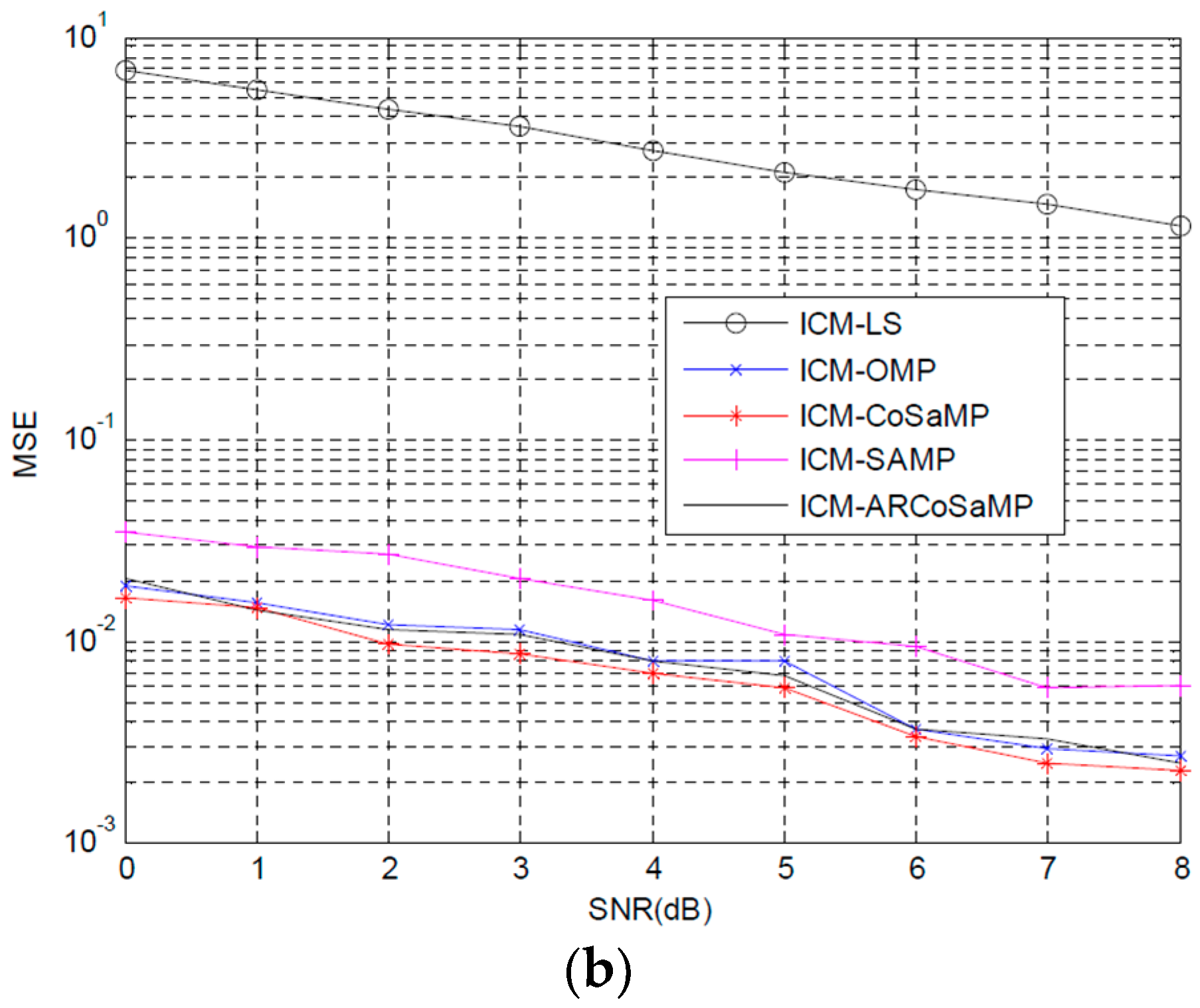
| Multi-Paths | 1 | 2 | 3 | 4 | 5 | 6 |
|---|---|---|---|---|---|---|
| Delay() | 0 | 3 | 8 | 11 | 13 | 21 |
| Power(dB) | 0 | −7 | −15 | −22 | −24 | −19 |
| Multi-Paths | 1 | 2 | 3 | 4 | 5 | 6 |
|---|---|---|---|---|---|---|
| Delay(μs) | 0 | 3 | 8 | 11 | 13 | 21 |
| Power(dB) | 0 | −7 | −15 | −22 | −24 | −19 |
© 2016 by the authors; licensee MDPI, Basel, Switzerland. This article is an open access article distributed under the terms and conditions of the Creative Commons Attribution (CC-BY) license (http://creativecommons.org/licenses/by/4.0/).
Share and Cite
Wang, H.; Du, W.; Xu, L. A New Sparse Adaptive Channel Estimation Method Based on Compressive Sensing for FBMC/OQAM Transmission Network. Sensors 2016, 16, 966. https://doi.org/10.3390/s16070966
Wang H, Du W, Xu L. A New Sparse Adaptive Channel Estimation Method Based on Compressive Sensing for FBMC/OQAM Transmission Network. Sensors. 2016; 16(7):966. https://doi.org/10.3390/s16070966
Chicago/Turabian StyleWang, Han, Wencai Du, and Lingwei Xu. 2016. "A New Sparse Adaptive Channel Estimation Method Based on Compressive Sensing for FBMC/OQAM Transmission Network" Sensors 16, no. 7: 966. https://doi.org/10.3390/s16070966
APA StyleWang, H., Du, W., & Xu, L. (2016). A New Sparse Adaptive Channel Estimation Method Based on Compressive Sensing for FBMC/OQAM Transmission Network. Sensors, 16(7), 966. https://doi.org/10.3390/s16070966







